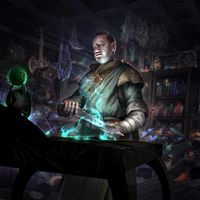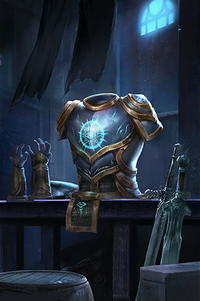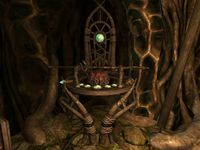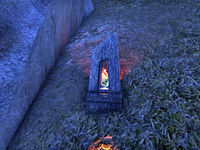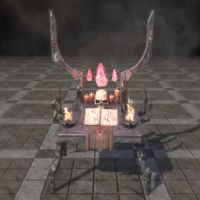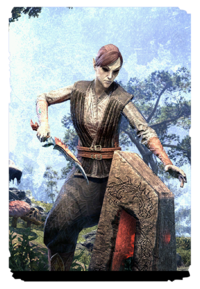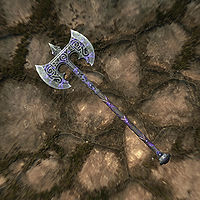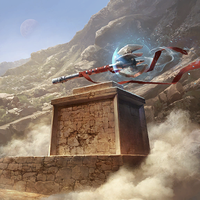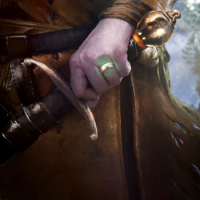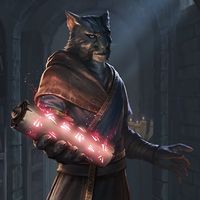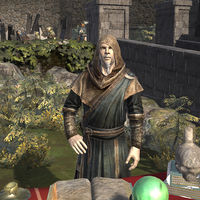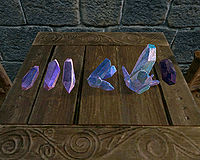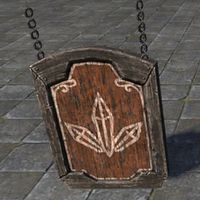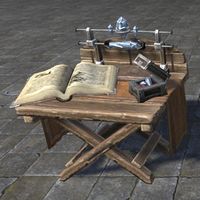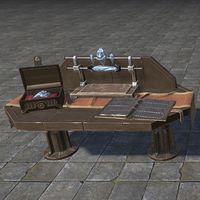Lore:Enchanting
Enchanting is the act of endowing objects with magical properties through the use of various ingredients and tools,[1] and a soul, almost always with the use of a soul gem. An enchanted item's power diminishes with use, in which case additional souls may be used to replenish it. The strength of an enchanted item and the amount by which it can be recharged is directly related to the magnitude of the souls used.[2] The enchanting discipline concerns imbuing physical items with magical properties called enchantments. The simplest enchantments are magical scrolls with a single enchantment that are destroyed with one use. The most complex enchantments are enchanted artifacts, objects with one or more magical effects powered by built-in soul gems. Skilled enchanters also use enchanted items more efficiently, with less waste of the magicka trapped in the soul gems,[3] and even make greater use out of the enchantments. It is said that a skilled enchanter is also a catalyst, and that a ring that can generate warmth for a novice, on the hand of a talented enchanter could "bake a forest black".[4]
It is said that Raven Direnni created the art of enchantment in the First Era,[5][6] though grand enchanters such as Ahzidal of Merethic Era predated her discoveries.[7][8] According to other sources, the enchantress merely improved an existing process by developing the Rules of Eldritch Binding. Before her work, the process failed nine times out of ten.[9]
Prior to Vanus Galerion's foundation of Mages Guild magical services, including enchanted items were not available to the general public in the Summerset Isles. The art of magic, including enchantment, was primarily limited to the aristocracy or intelligentsia. The creation and use of magical items were generally kept within the confines of magical institutions such as the Psijic Order, and the general public had limited access to them.[10] Some sources claim that the praxes and rituals used by all modern potionmakers, itemmakers, and spellmakers were originally codified by Vanus Galerion. Galerion is said to have restructured the schools of magic so they'd be understandable by the masses and to have invented the tools of alchemy and enchanting so everyone could concoct whatever they wanted without fears of magical backfire. It is said that the original tools of enchanting and alchemy that Galerion crafted were more automated than modern ones, robotic master enchanters and alchemists that could create anything the customer asked for as long as they paid for it and could be used for that purpose by any layman, even without any understanding of magic. Even an enchanted sword that could "cleave the world in twain" is said to have been theoretically possible to make through these original tools, obstructed only by the enormous cost in magicka and gold. This level of accessibility is said to have resulted in a number of incidents where laymen created dangerous arcane objects beyond their ken. Galerion is said to have eventually realized the danger his original enchanting and alchemy tools posed, and to have had them destroyed and replaced by less automated versions which required users to have some understanding of what they were doing to use them. Because of these contributions to making the study of magic more accessible and free, Galerion is described in some sources as the originator of the practice of magic in its modern form.[11]
The Mages Guild considered enchanting to be potentially dangerous to the public at large, and restricted its use to higher-ranked Guild members in good standing by the Council of Mages.[12] Because the temptation to experiment with Black Soul Gems is strong and dangerous, enchanters tend to learn their craft under heavy supervision.[13]
It is possible to utilize alchemical reagents for enchantments.[14][15]
Some materials are prized by enchanters for their properties in the forging of enchanted weapons and armors, such as Meteoric Iron.[16] Cold Iron is known for holding enchantments very well.[17]
The act of imbuing Ebony with Daedric essences to create Daedric gear such as armor was considered related to the art of enchanting and a point of pride among enchanters[18]
Sigil Stones can be used to enchant gear, and can even surpass the strength of enchantments made with bigger soul gems.[19][20]
Usage[edit]
According to the College of Winterhold, before a weapon or bit of armor can be enchanted, a wizard must first learn the enchantment. This is considered a personal task, as enchantments cannot easily be passed from one mage to another, and must be understood at a primal level that can only be achieved by destroying an enchanted item and absorbing its nature.[2] However, it was also possible for a mage to enchant items using spells they knew, without having to disenchant items first.[3][21][19] This might be due to some of the nuances of this skill being lost when the Imperial City was sacked.[2]
Arcane Enchanters are specifically designed for disenchanting. Merely placing an enchanted item in the device and willing it to relent causes the magic to flow into the mage, imbuing them with the knowledge of how the enchantment is formed. The utter destruction of the enchanted item is considered the unavoidable consequence of this process.[22] Altars of Enchantment are powered by candles made from magetallow.[23]
Before beginning an enchantment, a filled soul gem is needed. The enchantment uses the soul as a source of power. Placing the item and the soul gem on the Arcane Enchanter and concentrating on the enchantment allows the device to meld the two together, enchanting the weapon or armor. Enchantments created by lesser skilled mages require a lot of the soul energy. More skilled mages, however, can achieve the same effects with less soul energy.[2]
According to the book Twin Secrets, once enchanted, an item cannot be enchanted again. This is called the Law of Firsts: the first enchantment is the only one that takes. However, a mage named Brarilu Theran discovered the secrets of imbuing an item with two enchantments. According to the mage, a Dragon shared the secret that a skillful enchanter can weave two enchantments simultaneously into an item. For men and elves, the limit is two. The dragon said that men and elves have two arms, two legs, two eyes and two ears. When asked why that mattered, the Dragon simply laughed. The enchanter must weave one enchantment with the left hand while weaving the other with the right. The eyes must focus on one and only one enchantment, while the ears only pay attention to the other. When asked about legs, the Dragon laughed again. Brarilu spent two years mastering the technique, and managed to make a sword with both fire and fear enchantments.[24] This theory is however contradicted by the sword Chrysamere being enhanced by new enchantments as it moved from person to person, and The Wolf Queen, v8 talking about the possibility to reenchant an item.[25]
Types of Enchantments[edit]
Armor Enchantments[edit]
Enchantments that enhance health, magick, and stamina are the most commonly used for armor and other clothing. Improving health is a popular choice among warriors as it makes the wearer more resilient to attacks by binding their life force closer to their body. Fortifying magicka, on the other hand, is typically used in clothing as wizards prefer lighter, more flexible attire. It allows them to cast more spells before becoming magically exhausted. Fortifying stamina is a secondary choice for fighters as it helps them avoid becoming tired quickly, but does not increase their chances of survival.
Enchantments can fortify a wide range of physical and mental attributes or skills, with as many options as the imaginations of wizards. Some popular examples include archery, sneaking, conjuration, and carrying strength, with the focus often being narrow. Some enchanters even create gauntlets specifically designed to improve the wearer's ability to enchant items.
Another prevalent type of armor enchantment is the resistance enchantment. Elemental resistance enchantments are relatively more common and easier to create. They can make the wearer less vulnerable to fire, ice, and shock damage. There are also poison resistance enchantments and those that provide resistance to all forms of magic.
A rare pair of enchantments include waterbreathing and muffle. The former allows the wearer to breathe underwater without limit, while the latter completely suppresses the noise produced by the armor, allowing for quieter movement. Some have speculated that muffle is a wizard's simplistic solution to a problem that could be solved more easily with cloth and wrappings.
Enchantments that increase the recovery rate of health, magicka, or stamina are among the rarest of the enchantments. With these enchantments, the wearer can heal from their wounds even in the midst of battle. Wizards, who normally recover their magical energy at a moderate pace, can recover much faster with enchanted armor. The same is true for stamina recovery enchantments - the wearer still tires as quickly as usual, but they recover their energy faster.[26]
Certain armor enchantments are regarded as permanent and do not require charging or powering. The reasons behind this phenomenon remain unknown, but some members of the College of Winterhold speculate that the wearer contributes a small amount of their own energy to keep the armor enchanted. Others believe that it is simply the result of the will of Magnus.[2]
Weapon Enchantments[edit]
Enchantments that enhance a weapon's offensive capability are common and varied. Many magical creatures resist normal weapons and require silver or better to be harmed; enchanting a weapon is one way to circumvent these resistances.[27]
The most popular offensive enchantments include fire, frost, and shock enchantments, which imbue the weapon with a magical strike upon impact. Less common, but still widely used, are enchantments that drain magicka, and stamina, cause fear, or turn undead. These enchantments cause their victims to lose magicka or stamina without actively using it, make opponents lose their courage and flee, or cause undead to turn away in fear.
Rare and coveted are absorb enchantments, also known as vampiric enchantments, which drain the victim's health, magicka, or stamina, restoring the wielder in turn. These enchantments act as a conduit between the wielder and their opponent, allowing the wielder to steal the opponent's attributes.
Enchantments that inflict banishment and paralyzation are among the rarest. Banishment can sever the link between a summoned Daedra or undead creature and its summoner, resulting in the Daedra returning to Oblivion or the raised undead being released from service. However, self-willed undead are unaffected by banishment. Paralyzation renders the victim immobile and defenseless, making it easy to attack and defeat them.
An enchantment that serves a more utilitarian purpose is a soul trap, which allows the wielder to capture the soul of a slain creature. This enchantment does not directly increase the weapon's offensive capability, but rather provides a means of obtaining powerful souls for use in enchanting or recharging other enchanted items.[28]
Enchantments on weapons gradually consume the soul energy within them until they are exhausted. Although the enchantment remains, a filled soul gem is needed to recharge the weapon. Some speculate that the reason for this is the destructive nature of the weapon enchantment. Others suggest that the soul gradually leaks out into the victims that the weapon harms.[2]
Staves can also be enchanted, both with the usage of traditional methods and with glyphs.[29][30] Azra Nightwielder was a pioneer in the field of enchanting staves. His methods grew to be considered rudimentary by the standards of the Fourth Era, but he was still conisdered genius in his field. Neloth of House Telvanni studied Azra's creations.[31]
Miscellaneous Enchantments[edit]
A variety of utilitarian and vanity enchantments exist, bringing a touch of magic and aiding in the every day of Tamriel's people.
A variety of enchanted items exist to make busy-work easier, such as brooms that can sweep room by themselves,[32] hands-free use,[33] and text replicating quills,[34] pails that magically and autonomously milk cows,[35] tools that determine the quality of farming soil,[36] hooks that detect when a crocheter misses a stitch,[37] life-like bait to assist in fishing,[38] magic soil that helps plants grow,[39] and even at least one-thousand and one guar related enchantments.[40]
The fields of medicine and hygiene are also benefited by enchantment due to devices such as ensorcelled prosthetics which bend and flex like natural tissue,[41] bands which indicate the reproductive chances of a pair,[42] vision-enhancing lenses,[43] and air-purifying bits.[44]
In certain cases, enchantments on objects can be used to facilitate interaction with spirits to some degree, such as wind flutes that were enchanted to summon benevolent spirits,[45] or staves that housed pacifying spirits.[46]
Enchanting can be used to transcend death in form of the undead. Arch-Mage Shalidor put a powerful enchantment on his final resting place that allowed him to return from Aetherius whenever their legacy is threatened.[47] Enchantments that ensured the reanimation of a person's corpse as a skeleton after death were available for purchase.[48]
Skinmail is an armor of myth and legend created via decades worth of attentive work in both alchemy and enchantment to produce. They are the result of vials of experimental liquids which upon contact with skin, will harden it and produce plate-like coverings to the wearer's liking. Skinmail was created by an Altmer alchemist, who performed profane experiments on live subjects to reach the results they desired.[49]
Runestones and Glyphs[edit]
A form of enchanting common in the Second Era was utilizing Runestones and using special instruments to assemble them into Glyphs. There were three types of Runestones, called Aspect, Potency, and Essence. Potency runes determined the glyph's strength. Aspect affected the glyph's quality. Finally, the Essence rune decided the glyph's effect.[50] These three types of runestones were understood to be mystically complementary, for only by combining one of each category could an enchanter create a "glyph," the term used for the magical substance used to endow an item with sorcerous power.[51] A glyph was just a simple gem that anyone could attach to the pommel of a sword or on a piece of armor. Once attached the magic in the glyph would flow into the item.[1] Glyphs were said to be very particular, as some were best for weapons, others for armor, and still more bound only to jewelry.[52] Runestones could be recovered back out of an already made glyph by extracting them.[53]
Runestones were found sitting in angular stones, which have a distinctive flare of light. They were likely to be found in dangerous places, such as outside the ancient ruins of Tamriel. They tended to gutter out if kept away from starlight. It was considered a rare exception for runes to be clustered closely together.[52][53] Runestones could be pried out of their housing using rune extracting tools.[54]
The origin of the runestones are obscure and uncertain, with even their nature and material composition being a matter of debate among scholarly circles such as the sages of the Crystal Tower. A Sapiarch of Mythohistory claimed that a passage in Torinaan's Journal indicates that runestones were already present when the Foresailor arrived from Aldmeris. A Sapiarch of Enchantment, however, contended that they date from the early Merethic Era, and are the unintended consequence of an Ayleid wizard's experiment gone awry.[51] Another theory was that the runestones were a language that was entirely invented by a Dawn Era enchanter or school of enchanters who left no other record of their existence other than the spread of runestones across Tamriel.[55] A possible theory of the runes transcending the veil and originating from Oblivion was put forth when the Antiquarian Circle discovered and rebuilt a Daedric enchantment table which also harnessed this same form of runic magic.[56] While their origins remain unclear, after generations of study, their various properties have nearly all been identified, and their uses in the enchantment of arms, armor, and ornaments are well understood.[51]
Despite countless research, an enigma remained about the true nature of the runestones. Even Phariiz the Antic, who named the various types of runestones, did not know why he named them in such manner, except that they felt right to him. Even the fact that there are three kinds of runestones has generated much debate, as it is said to contradict the Anu-Padu Theorem, which posits that duality is the foundation of the Aurbis. A scholar named Camilonwe of Lillandril asserted that it was impossible that there were only three types of runestones, and spent the last two hundred years of his life searching for a fourth, convinced that proper classification called for such entities to appear in dual pairs. He never found this "quartonic runestone," which he dubbed Celerity, but he insisted until the end that his theory was sound.[51]
Each runestone has a rune inscribed on it, which form the basis of the Rune-Language used by enchanters. Alone, a rune is inert, but magical potential is unleashed when combined with others in the appropriate syntax. The full form, the complete expression, conveys magic. An enchanter does not need to fully understand the language to unlock the power it contains, as not enough words exist or are known to truly speak it, but by studying glyphs and combining runestones, it is possible to grasp enough of the raw concepts to utilize it. The language has been said to be undeniably connected in a fundamental way to magical energies, though its origin remains a mystery, as they are not derived from any known historic or pre-Dawn culture.[57][55]
While new runic developments happened fairly regularly, the runic language was a linguistical common tongue amongst enchanters that allowed them to imbue items with mystical properties. Runes have specific, measurable meanings and allow for a repetition of output as well as intent, and it is a discipline which was said to require precision and artistry in equal measure.[58] It was said that the act of enchanting revealed the meaning and function of runes unknown to an enchanter, and the Mages Guild claimed that one must comprehend how the rune resonates within one's soul to truly understand it.[52] The deciphering of runestones was aided by repetition of words and phrases one has already learned, and the extraction of runes from glyphs, allowing enchanters to obtain the knowledge they needed to master more difficult runes.[57]
Some claimed the utilization of glyphs caused a collapse of the enchanting market. Instead of the price for an enchantment being set on a city-by-city basis, all of the enchanters of Tamriel had to compete with each other. A hedge enchanter in Daggerfall could make ten fire glyphs and sell them to a traveling merchant, who could bring them to the Imperial City and sells them in the marketplace, at a price much below the price set by the Cyrodilic enchanters. Due to these reasons, some enchanters requested for a ban on the importation of foreign manufactured glyphs.[1]
Certain enchanted tools were developed to improve the process of rune extraction, such as Reachmen tools inlaid with numerous Reach enchantments, considered perfect for rune extraction and a hallmark of the Karth River Reach clans.[59] Ashlanders of the wastes had their own manner of Runegathering using their sharp blades.[60] It was possible to gather runestones utilizing a technique that involved covering one's fist in ice.[61] A Bosmeri method of gathering runestones, sometimes from Ayleid ruins, was called Rune Diving, where a Green Pact adherent would travel along a graht-oak bough until they spot a runestone glimmer, drop down using a vine, pry it out and ascend back, all without touching the ground.[62]
Notable Enchanters[edit]
- Ahzidal — Ancient Nordic enchanter of great renown.
- Almion Celmo — The enchanter of Ice Blade of the Monarch.
- Azra Nightwielder — The original Shadowmage and master of staff enchanting.
- Carni Asron — The enchanter of Mentor's Ring.
- Dorach Gusal — The enchanter of Skull Crusher.
- Malyn Varen — The master enchanter who experimented on the Azura's Star.
- Naenra Waerr — The ancient witch credited with creation of Umbra.
- Raven Direnni — A Member of Clan Direnni credited with creating the Rules of Eldritch Binding, considered by some sources to be the first enchanter.
- Zurin Arctus — Imperial Battlemage of Tamriel and enchanter of the legendary Dragonbone Mail.
Gallery[edit]
Runic text
Notes[edit]
- For obscure reasons, the Telvanni prefer to use tantos, as opposed to standard daggers, as a matrix for their enchantments.[63]
- Binding words can be used to destroy enchanted items.[64]
See also[edit]
For game-specific information, see the Daggerfall, Morrowind, Oblivion, Skyrim, Elder Scrolls Online, and Blades articles.
Books[edit]
- A Request for Relief by Defessus Magister — An enchanter's plea regarding manufactured glyphs and the collapse of the enchanting market
- Ahzidal's Descent by Halund Greycloak — The tale of a powerful enchanter's descent into madness
- Catalogue of Armor Enchantments by Yvonne Bienne, Synod researcher — An incomplete list of all the spells and armor used in enchanting
- Catalogue of Weapon Enchantments by Yvonne Bienne, Synod researcher — An incomplete list of all the spells and weapons used in enchanting
- Enchanter's Primer by Sergius Turrianus — A guide for novices in enchanting issued by the College of Winterhold
- Enchanting Made Easy by Fishes-for-Runes — A beginner's guidebook to enchanting with runestones
- Enigma of the Runestones by Telenger the Artificer — On the runestones of Tamriel
- Feyfolken by Waughin Jarth — The Great Sage tells a story of Artaeum, Psijics, and Robotic Enchanters
- Glyphs and Enchantment by Sanessalmo of Glister Vale — A brief overview of enchanting glyphs and runestones
- Malham's Annotated Compendium of Arcane Contrivances of the Second Age, Volume IV by Malham
- Malyn Varen's Grimoire by Malyn Varen, Master Enchanter — A proud mage boasts of altering a Daedric artifact
- Palla by Vojne Mierstyyd — A conjurer's tragic infatuation with a dead woman
- Tamrielic Lore: Revised by Yagrum Bagarn — A list, compiled by the last living Dwemer, of ancient artifacts
- Twin Secrets by Brarilu Theran — A tale of an enchanter's path to discovering how to weave two enchantments onto one item
- Words and Power by Telenger the Artificer — A scholar presents his radical theory regarding language
References[edit]
- ^ a b c A Request for Relief — Defessus Magister
- ^ a b c d e f Enchanter's Primer — Sergius Turrianus
- ^ a b Enchant generic dialogue in Morrowind
- ^ Palla — Vojne Mierstyyd
- ^ De Rerum Dirennis — Vorian Direnni
- ^ Raven Direnni's Inflammable Rug in ESO
- ^ Ahzidal's Descent — Halund Greycloak
- ^ Ralis Sedarys' dialogue in Skyrim: Dragonborn
- ^ Once — Beredalmo the Signifier
- ^ Origin of the Mages Guild — The Archmage Salarth
- ^ Feyfolken — Waughin Jarth
- ^ Manual of Spellcraft
- ^ Greater Soul Gem description in Blades
- ^ Agents and Reagents: The Bounty of Mundus
- ^ Enchanting in Blades
- ^ Magic from the Sky — Irlav Jarol
- ^ Treatise on Metallurgical Anomalies — Ovuld, Master Metallurgist
- ^ Earnaana's dialogue in ESO
- ^ a b Enchanting in Oblivion
- ^ Sigil Stones in Oblivion
- ^ Enchanting in Morrowind
- ^ Farengar Secret-Fire's dialogue during Enchanting Tutorial in Skyrim
- ^ Magetallow Candles Box for Altar of Enchantment in Wizard's Tower DLC in Oblivion
- ^ Twin Secrets — Brarilu Theran
- ^ The Wolf Queen, v8 — Waughin Jarth
- ^ Catalogue of Armor Enchantments — Yvonne Bienne, Synod researcher
- ^ Resist Normal Weapons effect in Oblivion
- ^ Catalogue of Weapon Enchantments — Yvonne Bienne, Synod researcher
- ^ Staff Enchanter in Skyrim
- ^ Enchanting in ESO
- ^ Neloth's dialogue in Skyrim: Dragonborn
- ^ Enchanted Broom
- ^ Enchanted Dictation Quill
- ^ Maven Black-Briar's dialogue in Skyrim
- ^ Enchanted Hand Pail
- ^ Enchanted Soil Probe
- ^ High Iron Crochet Hooks
- ^ Writheleaf Fly Fishing Lure
- ^ Y'ffre's Blessed Soil
- ^ 1001 Guar Enchantments
- ^ Box of Wood Fingers and Toes
- ^ Coupling Band
- ^ Eagle's Gaze Monocle
- ^ Ever-Breath Smith's Bit
- ^ Enchanted Silver Flute
- ^ Staff of the Spirit Within
- ^ Arch-Mage Shalidor's dialogue in ESO
- ^ Tarshea's dialogue in ESO
- ^ Armor of Myth and Legend — Aurelienne Dulroi
- ^ Enchanter Dialogue in ESO
- ^ a b c d Enigma of the Runestones — Telenger the Artificer
- ^ a b c Enchanting Made Easy — Fishes-for-Runes
- ^ a b Danel Telleno's dialogue in ESO
- ^ Melina Cassel's dialogue in ESO
- ^ a b Telenger the Artificer Answers Your Questions — Telenger the Artificer
- ^ Daedric Enchanting Station antiquity in ESO
- ^ a b Words and Power — Telenger the Artificer
- ^ Loremaster's Archive - The Arcanists — Azandar al-Cybiades
- ^ Reach Witch Removal in ESO
- ^ Ashen Runegathering in ESO
- ^ Icefist Runegathering in ESO
- ^ Gaereleth Surefoot's dialogue in ESO
- ^ Garothmuk gro-Muzgub's dialogue in Morrowind
- ^ Meer-Ta, the Zephyr Eternal's dialogue in ESO
| ||||||||


